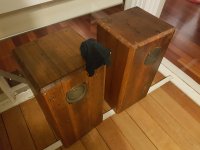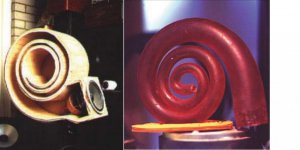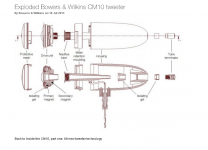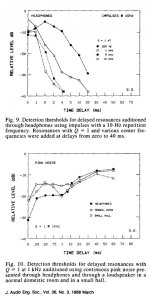That seems valid.I would think the amount of attenuation needed varies with frequency?
With moderate stuffing, I recorded <15dB attenuation up to ~2.5kHz.
Heavy stuffing had <15dB attenuation to ~500Hz.
I don't know how well the poor attenuation up to these frequencies translates to audibility.
One way it could be simulated and tested:
- start with a well recorded track with natural vocals. Reduce the volume by 2dB, then use a shelf filter to reduce the range above 400Hz by another 10dB. This would be to mimic the attenuation that box stuffing gives).
- paste the modified track over the original track, with varying amounts of delay (1ms, 2ms and 3ms)
- swap between the 4 tracks, through headphones, to see if the difference can be heard / to see which sounds worse.
Do you have the appropriate software to cook up a file like this?
BTW I would still try use quasi-anechoic measurement methods here. Flipping the box around to get different measurements changes how it interacts with the room and you won't be comparing apples to apples anymore. So either use gated or close mic techniques.
I could do more and different tests, but what would you hope to see?
e.g. if I test again, and my measure of cone leakage at 900Hz changed from "about 10dB louder than the box leakage" to "exactly 8.8358dB louder than the box leakage", how would that change anything? It's still going to be a whole lot louder.
I note that your Soma Sona site* shows a few nice looking speakers that have flat fronts. These appear to be suitable for you to duplicate my tests. Why don't you? This doesn't have to be conjecture
*BTW, did you realise that your photobucket links are all dead?
I would think the amount of attenuation needed varies with frequency?
Indeed. How much damping you need to attenuate is a a function of frequency. Also different materials have different characteristics. All struggle with LF.
See the charts in the 2nd half. Bradbury’s equations are in dispute.
Bradbury's Fiber Equations
dave
I’d suggest an aperiodic TL (a subset of what you have drawn)… suck the backwave down the line and damp the heck out of it.
Is that where the line's stuffing density is tweaked to give a near-flat impedance curve?
That's how I built the pictured boxes, mainly out of curiosity to try the impedance thing
This prior build is why I'm now thinking along these lines - but bigger and better. I think I'd try stuffing the line for maximum attenuation, rather than a perfect impedance curve (unless those goals overlap - I'm not sure).
*...and it sounds fine, but was mostly built to use up some rustic materials. The enclosure is recycled floorboards. I used dowels as the nails. The back panel is ugly: there's the TL output, two 6.5" woofers and their (bass reflex) port. The visible driver is a dodgy looking but nice sounding TV speaker that I chose after the 105WK failed the audition.
Attachments
hollowboy> if I understand what you are doing when measuring radiation through the cone, you flipped the box around. This will already change the signature, but change will be even greater if you are ungated and now the wall/floor/ceiling reflections are also changing. So you're not really isolating your variables. This is how misleading noise enters your measurements and you draw wrong conclusions. Just saying it is good practice to sweat those sorts of details, even when the measurements are just supposed to be comparative.
I'm in the process of moving and rebuilding my website due to the photobucket fiasco so it's a bit of a mess. Hopefully I'll get time in the next couple months. I do plan on doing this same sort of investigation, hopefully this summer. Got a house remodel to deal with first.
P10> I was more referring to audibility changing by frequency.
I'm in the process of moving and rebuilding my website due to the photobucket fiasco so it's a bit of a mess. Hopefully I'll get time in the next couple months. I do plan on doing this same sort of investigation, hopefully this summer. Got a house remodel to deal with first.
P10> I was more referring to audibility changing by frequency.
Indeed. How much damping you need to attenuate is a a function of frequency. Also different materials have different characteristics. All struggle with LF.
Thanks, but I realise this - it's one of the handful of things I remember from Vance Dickason's book.
15dB of backwave attenuation - cannot be achieved, especially below 400Hz (graphs 1&2, post 127). Lots of other tests have shown that box stuffing is ~useless in this range, so I see little reason to doubt this finding.
You may have missed the context (masking and phychoacoustics); an expanded version of the line you replied to would be:
"I would think the amount of attenuation needed [to make the reflected rearwave no longer perceivable] varies with frequency"
Is that where the line's stuffing density is tweaked to give a near-flat impedance curve?
That is the best way to judge when you are done. If you overstuff it starts approaching sealed.
dave
- If the rearwave has to travel 1 metre further than the frontwave before hitting the listening position, that's ~3 milliseconds of delay.
- lots of scattering should give a lot of attenuation.
...so I'm thinking of something like this crude picture.
Good. (and I’ve seen it implemented in a commercial loudspeaker, sorry I can’t remember which)
*other configurations would do this (or better)
- an OB >1m wide
- front loaded horns to 100Hz
- a soffit mounted IB
...but all are impractical / much too room dominating.
The aperiodic TL that Dave suggested works well.
I’d suggest an aperiodic TL (a subset of what you have drawn)… suck the backwave down the line and damp the heck out of it.
B&W Natilus approach works along these lines (when open ended, but it works as closed ended too with different stuffing of the line)
https://pearl-hifi.com/06_Lit_Archi...5_Bowers_Wilkins/B&W_Nautilus_Development.pdf
Exploded Bowers & Wilkins CM10 tweeter | Society of Sound
George
Attachments
B&W Natilus approach works along these lines (when open ended, but it works as closed ended too with different stuffing of the line)
I use ¼ wavelength lines (shorter & open), B&Ws is ½ w/l
dave
Thanks again Dave !
Craig
It would be an omission not to mention the (back loading) Cornu horn
George
*other configurations would do this (or better)
Craig
It would be an omission not to mention the (back loading) Cornu horn
George
The usefulness of a knuckle rap test in helping guide simulations about the damping for each of the lowest modes doesn't seem to be related to the physics one should see in the measurements. Simulations rather measurements is what is overwhelmingly used in industry for problems of this kind that are difficult to measure directly. So measurements from a knuckle rap test that provide a check that the simulated modes are correct is very useful even if it doesn't provide a forced response for the cabinet.To me, it looks like the 3rd point I underlined explains the earlier points: my experiments are tests a full assembly containing different materials. So are the tests in the two pages I linked (Ludwig's page and Csaba's page).
Materials aside: my experiments indicate that the rearwave emerging through the cone of my moderately stuffed box are 10-15dB louder than the rearwave that emerges through the cabinet (first graph, post 127). That's an enormous difference.
Around 300Hz, it is even worse / and harder to reduce. That seems like the thing to focus on.
...but maybe my methodology was flawed, and the real difference is 'only' 8-13dB
You can only have a flawed methodology if you know what you want to measure. I had been assuming you wanted to measure the forced or free response of the cabinet. I am now pretty confident this is not the case and that you don't actually know what you want to measure to the extent of being able to define it. Just something to do with the cabinet that you hope might be useful and will be fun playing about with.
Why don't I spend an hour doing something that serves no purpose that I can see? A quip here about my posting in this thread perhaps?Why don't you try it yourself? It takes less than an hour. The only awkward bit is removing and replacing the woofer(s).
It was pointed out by at least two people earlier in this thread why your backwave in a typical box isn't the problem you think it is.So far, what I've taken from this thread and my tests is that building a decent box is a fine idea, but an even better idea would be (subs +) a configuration that eats, ignores, delays or dissipates the backwave much more effectively than a typical box does (maybe a 'boffle' cabinet, compression drivers, etc).
My original idea was to run tests like Ludwig's (link on post one), and gather some ideas on how to build 'quiet' cabinets with low sound radiation through the walls. I was hoping to do so in a weight efficient manner.You can only have a flawed methodology if you know what you want to measure. I had been assuming you wanted to measure the forced or free response of the cabinet. I am now pretty confident this is not the case and that you don't actually know what you want to measure to the extent of being able to define it. Just something to do with the cabinet that you hope might be useful and will be fun playing about with.
...but since my other tests indicate that the amount of backwave that leaks through the cones is oodles larger, I'm now thinking that I should probably put some effort into investigating + treating this.
See my underlined points in post 127. I thought I was pretty clear.
Nope, I'm not making a dig at you. Just focusing on those underlined points. I'd like to know whether (like mine), most other cabinets also leak more sound through the cones than through the walls.Why don't I spend an hour doing something that serves no purpose that I can see? A quip here about my posting in this thread perhaps?
If others were clearly better, I'd consider copying them, or aspects of them.
I don't see this.It was pointed out by at least two people earlier in this thread why your backwave in a typical box isn't the problem you think it is.
A simple example: Cabinet diffraction is an easily measured defect.
...therefore, I should consider using large roundovers in my next build, to reduce this defect.
I see the reflected backwave as an easily measurable defect.
...therefore, I should consider mitigating it in my next build.
The only reasons not to attempt to mitigate it would be:
1) if the defect in question is not 'real' - that is, if it is below the threshold of audibility and/or masked by other sound
2) if the design change would be out of proportion to the defect (such as requiring unreasonable bulk or large additional expense)
If point 1) has been covered, and something has been published (or you know of test results that show this), please tell me where I can read them.
It would be an omission not to mention the (back loading) Cornu horn
I'd have thought designs like the Cornu or Hedlund horns (shallow, flat, no stuffing behind the driver) would reflect massively off the backwall of the cabinet.
....but possibly this is OK (well masked) because the reflection time is very short?
I'm not sure which type / delay is best (if anything). I'll try to make some files with Audacity to see which delays are best / worst (if I can hear them at all).
On simple subjective listening, I've seen several people including Dave (planet 10) say that having cabinet walls too near a driver = bad.
I would have thought so too, but this is from the EJ Jordan site:On simple subjective listening, I've seen several people including Dave (planet 10) say that having cabinet walls too near a driver = bad.
"Will the shallow VTL and DCR enclosures cause audible reflections behind the Eikona?
On the contrary, it will raise their frequency and make them easier to absorb through use of acoustic damping material placed behind the Eikona."
This is what has become of most interest to me in this thread. Why this persists. You are reading good sources of information as well as poor but the good is not getting the upper hand. Perhaps it is because you have made up your mind to do things in a particular way and information indicating it isn't going to produce anything particularly useful is unwanted to the extent it is dismissed. Whatever, interesting stuff (and not unrelated to future projects of my own) and so long as you are enjoying it as part of your hobby interests that is probably what matters most.I don't see this.
I'd have thought designs
If you can avoid early reflections at the rear of the driver, do it.
If you can heavily attenuate them, do it.
If you can’t, try to minimize the delay as much as possible.
Reflections from the chassis basket are in the range of 0.1 to 0.2ms
A back reflection from a surface 10cm from the flange is delayed by 0.6ms.
40cm from the flange is delayed by 2.3ms.
Please try the test with Audacity and inform us
All the diagrams of Chapter 6 in Floyd Toole’s "Sound Reproduction" book show reduced perception effects for very short delays compared to short delays
Sound Reproduction: The Acoustics and Psychoacoustics of Loudspeakers and Rooms (Audio Engineering Society Presents): Floyd E. Toole, Floyd Toole: 8601300165110: Amazon.com: Books
The benefit of increasing cabin depth is that it allows the use of more sound absorbing material, thus achieving increased back reflection attenuation.
George
Hollowboy
I do think that your testing has had some positive results. You have concluded that sound radiation through the box walls is negligible, which agrees with what we have mostly been saying. You have shown the sound radiation through the cone is much more significant, that's a good point. But I think that it remains to be seen if this is significant given the direct sound radiation. This would also be highly dependent then on the specific woofer being used, indicating that a light weight woofer cone, you know one that is claimed to be "fast", would be undesirable. That a much heavier cone, like the pro units that I use, would be much better in this context.
But still a good study all-in-all.
I do think that your testing has had some positive results. You have concluded that sound radiation through the box walls is negligible, which agrees with what we have mostly been saying. You have shown the sound radiation through the cone is much more significant, that's a good point. But I think that it remains to be seen if this is significant given the direct sound radiation. This would also be highly dependent then on the specific woofer being used, indicating that a light weight woofer cone, you know one that is claimed to be "fast", would be undesirable. That a much heavier cone, like the pro units that I use, would be much better in this context.
But still a good study all-in-all.
Most of the topics discussed here, have been investigated by B&W in this link:
http://bwgroupsupport.com/downloads/reference/bw/800_Development_Paper.pdf
George
http://bwgroupsupport.com/downloads/reference/bw/800_Development_Paper.pdf
George
I tried it, expecting to hear a subtle difference.Please try the test with Audacity and inform us
I copied file A, equalised it to ~match the spectrum of sound I got through the stuffing & woofer cones, then delayed that file B by 1,2 & 3 milliseconds.
I expected a subtle shift. What I heard was way too rotten to be believable. Even when I cut (B) by 40dB above 1kHz, the mixed sound was like a ghetto blaster in a bathroom ...so I think my initial tests were flawed.
I need more sound editing skillz, or to actually build and compare something that eats the backwave versus a regular box.
Anyway: since the sound that leaks through the cones is largest <500Hz, it may be that this is just a ghost hunt. It may not be very audible.
Lets keep in mind that below about 1 kHz (500 Hz certainly) the audibility of timing delayed aberration events falls off very fast. I would not think that foam would have any effect on LF devices. I try and control the diffraction only above about 1 kHz. I don't worry about it too much below 500 Hz.
The best paper I found on the topic was:
The Modification of Timbre by Resonances
and Measurement*
FLOYD E. TOOLE AND SEAN E. OLIVE
...and that seems all over the place. I found it unusually hard to interpret.
The info pictured here seems to agree with Dr Gedde's statement above, for sustained (pink) noise, but disagree for impulses, but I may be reading it incorrectly, or trying to compare apples to hedgehogs.
Attachments
- Status
- This old topic is closed. If you want to reopen this topic, contact a moderator using the "Report Post" button.
- Home
- Loudspeakers
- Multi-Way
- Measuring sound output from speaker cabinet walls



